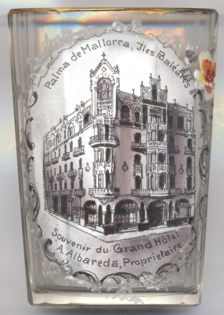

|
| ESPAÑA | Spain |
| Islas Baleares | Balearic Islands |
Palma de Mallorca is the capital and largest city of the autonomous community of the Balearic Islands in Spain. It is situated on the south coast of the island Majorca on the Bay of Palma. As of the 2009 census, the population of the city of Palma proper was 401,270, and the population of the entire urban area was 621,000, ranking as the twelfth largest urban area of Spain. Almost half of the total population of Majorca live in Palma. The Cabrera Archipelago, though widely separated from Palma proper, is administratively considered part of the municipality.
Palma was founded as a Roman camp upon the remains of a Talaiotic settlement. The city was subjected to several Vandal
sackings during the fall of the Western Roman Empire, then reconquered by the Byzantine Empire, then colonised by the Moors
(who called it Medina Mayurqa) and, in the 13th century, by Jaime I of Aragon (Jaime the Conquistador).
From that time, the city was mostly called Ciutat de Mallorca.
The city's privileged geographical location allowed it to keep extensive commerce with Catalonia, Valencia, Provence, the Maghreb,
the Italian republics and the dominions of the Great Turk, which heralded a golden age for the city.
At the beginning of the 16th century, the Rebellion of the Brotherhoods (a peasant uprising against Emperor Charles V's
administration) and the frequent attack of Turkish and Berber pirates caused a reduction of commercial activities.
 As a consequence, the city entered a period of decadence that would last till the end of the 17th century. At the beginning of the
18th century, the old Roman name, Palma, was rediscovered and since then remained in use.
The fall of Barcelona in 1714 meant the end of the War of the Spanish Succession and the defeat and
destruction of the Crown of
Aragón, and this was reflected on the Nueva Planta decrees, issued by Philip V of Spain in 1715. These occupation decrees
changed the government of the island and separated it from the municipality's government of Palma, which became the official
city name. Palma became the capital of the new province of Balearic Islands in the 1833 territorial division of Spain.
Since the 1950s, the advent of mass tourism radically changed the face of both the city and island, transforming it into a centre
of attraction for visitors and attracting workers from mainland Spain. At the beginning of the 21st century, the name was
changed back and forth between Palma and Palma de Mallorca; since 29 November 2016, the official name is again
simply Palma.
As a consequence, the city entered a period of decadence that would last till the end of the 17th century. At the beginning of the
18th century, the old Roman name, Palma, was rediscovered and since then remained in use.
The fall of Barcelona in 1714 meant the end of the War of the Spanish Succession and the defeat and
destruction of the Crown of
Aragón, and this was reflected on the Nueva Planta decrees, issued by Philip V of Spain in 1715. These occupation decrees
changed the government of the island and separated it from the municipality's government of Palma, which became the official
city name. Palma became the capital of the new province of Balearic Islands in the 1833 territorial division of Spain.
Since the 1950s, the advent of mass tourism radically changed the face of both the city and island, transforming it into a centre
of attraction for visitors and attracting workers from mainland Spain. At the beginning of the 21st century, the name was
changed back and forth between Palma and Palma de Mallorca; since 29 November 2016, the official name is again
simply Palma.
[https://politica.elpais.com/politica/2016/11/29/actualidad/1480430223_375806.html]
The picture on glass no.3006 [left] shows the
 Gran Hotel
Gran Hotel
The glass is labeled in French: « Palma de Mallorca, Îles Baléares / Souvenir du Grand Hôtel /
A. Albareda, Propriétaire ». Antoni Albareda i Canals was the first owner of the hotel
and also the first to edit a travel guide about Mallorca reserved for the guests of his establishment.
[https://en.wikipedia.org/wiki/Palma,_Majorca;
https://en.wikipedia.org/wiki/Gran_Hotel_(Palma),
https://piafmajorque.es/guide-voyageur/visites-et-incontournables/gran-hotel-premier-hotel-luxe-majorque/]
![[scale]](lineal.jpg)